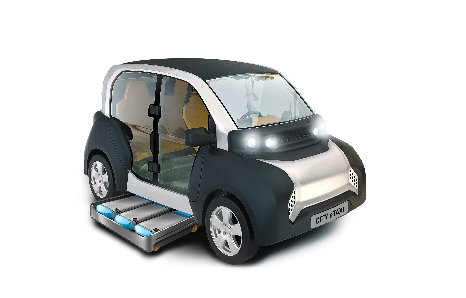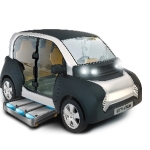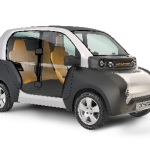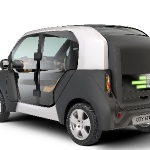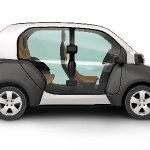The Adaptive City Mobility project, also referred to as ACM or CITY eTAXI, centres on the development of a zero-emission e-mobility system in municipalities. Its objective is to make e-mobility on four wheels environmentally and city-friendly on the one hand, and as affordable and thus competitive as possible on the other. To achieve this, the research project draws and is based on three technological innovations concerning a new vehicle concept, a new way of charging e-vehicles and the integration of an overall management and sharing system that allows the use of the vehicles by different user groups. Three innovations built the base of the total e-mobility system: an electric light vehicle, a battery swapping system and the intelligent integration of the various systems.
The result is a completely new car concept which is an explicit counter-statement to the current trends of the automotive industry. Rather than launching another two-ton car equipped with all kinds of luxury extras, the City eTaxi is a light vehicle weighing only 550 kg, including the battery. The low total weight is achieved by using a perfect and ultra-light mix of materials produced at minimum cost: an aluminium chassis, fibre-reinforced materials used for the safety passenger cabin and plastics for those parts which merely serve to cover the vehicle. The design of the vehicle follows the maximum usefulness it provides under the motto, “form follows function”.
Two of the factors standing in the way of a more widespread expansion of electric cars are the currently high purchase costs on the market as well as the relatively small range compared to that reached by combustion engine vehicles. Even though, in most cases, the fear of insufficient range is unsubstantiated, in some scenarios, such as taxi transportation, 300 km (and more) per day is actually normal. A core element of the ACM system is, therefore, the option to manually change the batteries thus maximising vehicle utilisation. Together with the use of renewable energies the reduction of CO2 emissions can even be increased and the whole ACM system achieves the status of a zero-emission mobility system.
To guarantee maximum efficiency and vehicle utilisation, the basic idea of ACM is to run the vehicle as part of a CITY e-Fleet, whose overall operation is controlled using modern information and communication technologies (ICT). In this system, all units, from the vehicles and battery replacement stations to the end-user apps and operating software, are interlinked and converge within the operator platform. In combination with the battery replacement system, this new sharing approach makes it possible to make the vehicles available to different user groups while at the same time supporting different modes of use. The aim is to maximise benefits and car utilisation by implementing a cross-sectoral concept whose centrepiece is a software system that makes it possible to employ these different modes of application at different billing rates. This way, the same CITY eTAXI can also be eTAXI, eLOG, eSHARE or eTOURI – available for both passenger and cargo transportation.


